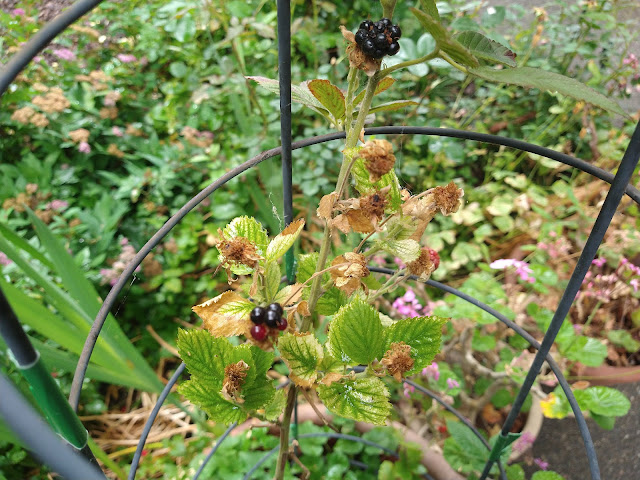
Poor blackberry pollination can be traced to spring weather

|
|
This Babycakes blackberry, a patio-size plant, produced just a few misshapen
berries this spring. Weather played a large part in the problem. (Photo: Debbie
Arrington)
|
This berry season, the bees let me down. My usually dependable blackberry plants bore precious few berries. The ones that did develop turned out misshapen. Instead of clusters of berries, the canes were covered with dried-up brown stubs.
I had lots of flowers – beautiful white blooms that usually attract bees with no problem. My blackberries grow near a big bed of roses; bringing pollinators into my backyard has never been a problem.
But this spring was different. In particular, my Babycakes dwarf blackberries fell victim to rollercoaster temperatures. Early April warmth (including 92 degrees on April 8) brought out the first berry blooms. But that was followed by a sudden plunge back into the 50s and frost on April 12. That sudden, unseasonable frost may have snuffed out pollinated blooms.
Once the flowers open, their stamens and pollen stay viable for only a short period (usually three days); they need bees when they need them. Honeybees don’t like wildly fluctuating temperatures. They don’t come out when it’s too cold or too hot, and it was both while those berries needed their help.
So the little pollination that did happen was extremely spotty; my guess, it was self-fertilization, not bees.
Adding to the berry dilemma were heat and drought, especially in June as berries were ripening.
Sacramento set a record for most 100-plus days in June; 11 days hit triple digits including a streak of eight straight. Three June days reached 104. That put heat stress on plants as berries were developing.
Vines already were thirsty. The last six months have been almost bone-dry, and even those notoriously vigorous blackberry roots were subject to dieback. Unless plants got supplemental irrigation, the vines tended to brown and often aborted berry production. (My Babycakes plant has the added challenge of growing in a large pot.)
And it’s not just my poor Babycakes that’s suffering. I’ve seen a similar lack of pollination and vine dieback in blackberries in our local greenbelt.
Fortunately, my vines are already sprouting healthy green growth. It’s time to cut out the old canes with their brown stubble, and move on. Maybe I can get a fall harvest? We’ll see what the bees are doing in August.
For more on blackberries and other caneberries, here are UC cultivation notes: https://www2.ipm.ucanr.edu/agriculture/caneberries/Growth-and-Development/ Also, here's good information from the Sacramento County master gardeners on growing caneberries in our region: https://ucanr.edu/sites/sacmg/files/74193.pdf
Comments
0 comments have been posted.Sacramento Digs Gardening to your inbox.
Sites We Like
Garden Checklist for week of Nov. 3
November still offers good weather for fall planting:
* If you haven't already, it's time to clean up the remains of summer. Pull faded annuals and vegetables. Prune dead or broken branches from trees.
* Now is the best time to plant most trees and shrubs. This gives them plenty of time for root development before spring growth. They also benefit from fall and winter rains.
* Set out cool-weather annuals such as pansies and snapdragons.
* Lettuce, cabbage and broccoli also can be planted now.
* Plant garlic and onions.
* Keep planting bulbs to spread out your spring bloom. Some possible suggestions: daffodils, crocuses, hyacinths, tulips, anemones and scillas.
* This is also a good time to seed wildflowers and plant such spring bloomers as sweet pea, sweet alyssum and bachelor buttons.
* Rake and compost leaves, but dispose of any diseased plant material. For example, if peach and nectarine trees showed signs of leaf curl this year, clean up under trees and dispose of those leaves instead of composting.
* Save dry stalks and seedpods from poppies and coneflowers for fall bouquets and holiday decorating.
* For holiday blooms indoors, plant paperwhite narcissus bulbs now. Fill a shallow bowl or dish with 2 inches of rocks or pebbles. Place bulbs in the dish with the root end nestled in the rocks. Add water until it just touches the bottom of the bulbs. Place the dish in a sunny window. Add water as needed.
* Give your azaleas, gardenias and camellias a boost with chelated iron.
* For larger blooms, pinch off some camellia buds.
* Prune non-flowering trees and shrubs while dormant.
* To help prevent leaf curl, apply a copper fungicide spray to peach and nectarine trees after they lose their leaves this month. Leaf curl, which shows up in the spring, is caused by a fungus that winters as spores on the limbs and around the tree in fallen leaves. Sprays are most effective now.